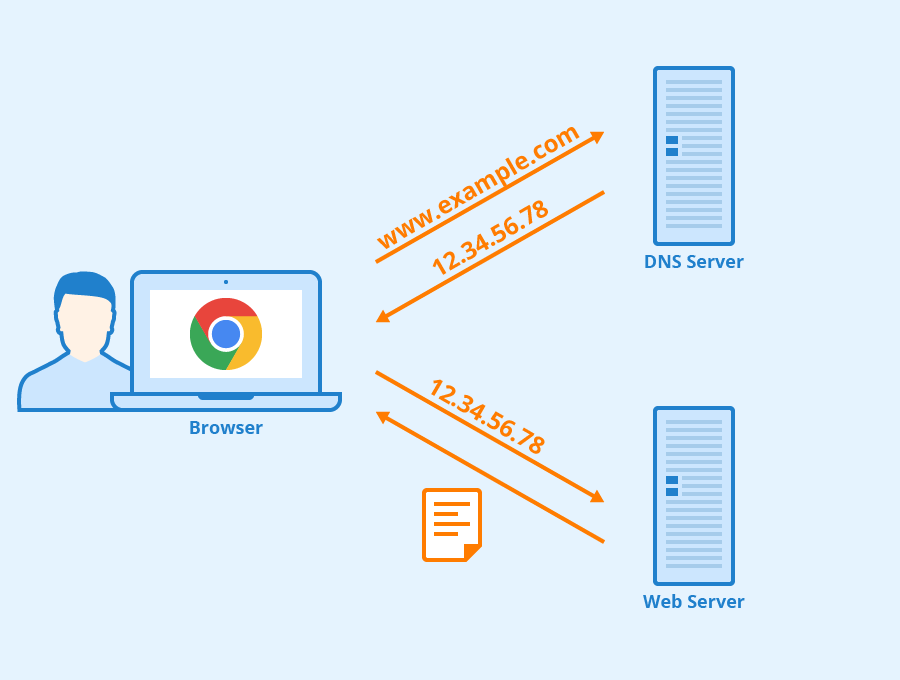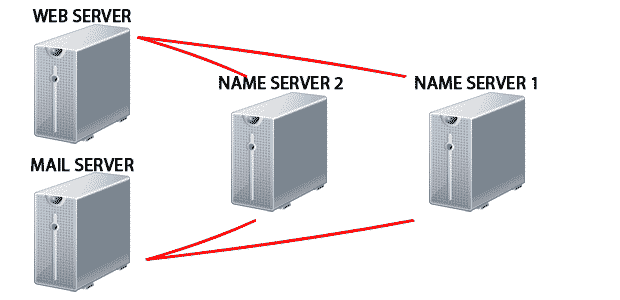Difference Between Name Server and DNS
The Internet or just any network fundamentally works by allocating a unique IP address to every host, server, interface, router, and so on, globally. An IP address is a logical number that identifies a computer on a TCP/IP network uniquely. The TCP/IP is a global networking protocol that facilitates communication between computers. TCP/IP makes sure a packet reaches the correct host. With hundreds of millions of hosts and millions of websites, it is impossible to memorize so many IP addresses. To solve this problem, the concept of name servers was created to enable the IP address of a named resource to be maintained in a decentralized location. The basic idea is to assign names to physical addresses. The Domain Name System (DNS) is a specific implementation of this concept of name server.

What is DNS?
DNS, short for Domain Name System, is a hierarchy of distributed database for computers or other resources connected to the Internet. It is like a phone directory of the Internet that provides access to information through domain names. DNS is fundamental to the operation of virtually all Internet Protocol (IP) network applications, from web browsing to email, multimedia applications, and more. DNS translates domain names into IP addresses so web browsers can load Internet resources. Every time you type a web address, send a mail, or access just any IP application, you use DNS. It translates a machine’s logical name to an IP address and then to a domain name. It converts human readable domain names like Google.com, Facebook.com into their corresponding IP addresses like 173. 194. 37. 78. DNS is a standard set of protocols that allow computers to communicate via the Internet.

What is Name Server?
A name server is a fundamental part of the DNS that helps connect URLs with the IP addresses of web servers. It is a dedicated server on the web designed to help you find websites by domain names. It is similar to the contacts list on your phone where instead of memorizing phone numbers, you assign names to numbers. Name servers work similarly by assigning an IP address to a domain name so you only have to remember the domain name instead of the IP address, which is convenient. A name server links your registrar to your hosting service provider. You need to change your name servers if your registrar and your hosting service provider are two separate companies. However, you do not need to do so, if your registrar and hosting service provider are the same company. The public name servers respond with the IP address; your computer dials the IP address and pulls up the web page associated with it.
Difference between Name Server and DNS
Definition
– The acronym DNS stands for Domain Name System, which is a hierarchy of distributed database for translating domain names into their corresponding IP addresses. DNS is a standard set of protocols that allow computers to communicate via the Internet. A name server, on the other hand, is a server where your DNS information is actually stored so that it’s accessible by the Internet. It is a fundamental part of the DNS that helps connect URLs with the IP addresses of web servers. A name server links your registrar to your hosting service provider.
Purpose
– Every time you type a web address, send a mail, or access just any IP application, you use DNS. It is fundamental to the operation of virtually all Internet Protocol (IP) network applications, from web browsing to email, multimedia applications, and more. DNS translates host names into IP addresses so web browsers can load Internet resources. Name servers, on the other hand, host or cache these translations. A name server is a server that hosts a name record or a referral record for a domain name.
Operation
– Name servers are a specialized database that translates names to properties, typically IP addresses, and vice-versa. They not only simplify network management but also make networks more dynamic and responsive to changes. If a name server is present in a network, the host only needs to know the physical address of a name server and the name of the resources. The DNS is a specific implementation of the concept of name servers optimized for the prevailing conditions on the Internet. DNS saves a domain name and its corresponding IP address to where the domain is hosted.
Name Server vs. DNS: Comparison Chart

Summary of Name Server vs. DNS
In a nutshell, DNS is a hierarchical distributed database for translating domain names into their corresponding IP addresses. Every time you type a web address, send a mail, or access just any IP application, you use DNS. Name server is a server that runs DNS software and manages all the domain name records. DNS solves three basic problems, organization, scalability, and management. The DNS uses a hierarchical name structure and its layers are arranged in a definitive order, and its data is distributed across a range of machines, each of which can enact control over a portion of the database.
- Difference Between Caucus and Primary - June 18, 2024
- Difference Between PPO and POS - May 30, 2024
- Difference Between RFID and NFC - May 28, 2024
Search DifferenceBetween.net :
1 Comment
Leave a Response
References :
[0]Dooley, Michael and Timothy Rooney. DNS Security Management. New Jersey, United States: John Wiley & Sons, 2017. Print
[1]Saltzer, Jerome H. and M. Frans Kaashoek. Principles of Computer System Design: An Introduction. Massachusetts: Morgan Kaufmann, 2009. Print
[2]Panek, William. MCSA Windows Server 2012 R2 Administration Study Guide: Exam 70-411. New Jersey, United States: John Wiley & Sons, 2015. Print
[3]Aitchison, Ron. Pro DNS and BIND 10. New York, United States: Apress, 2011. Print
[4]Image credit: https://upload.wikimedia.org/wikipedia/commons/d/d1/Showcase_of_nameservers.png
[5]Image rcedit: https://www.seobility.net/en/wiki/images/d/d0/DNS-Server.png

Hello Sagar
An excellent article on DNS and Name Servers. I was creating a course video for my students, and while collecting the contents, got confused by these two terminologies. You have explained the difference beautifully.